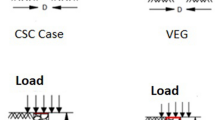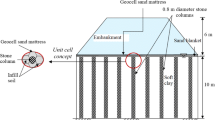Abstract
The use of industrial waste (ash) in large-scale earthworks for civil engineering applications such as construction of highway embankments, the rise of ash dykes, the filling low-lying areas, fillings of buildings, solves the problem of waste disposal besides in addition to the conservation of the natural soils. It is has a low density, low consolidation, lower potential for bearing and higher settlement. To use these areas for construction purposes, it is necessary to reinforce them at deeper depths. The present study uses highly confined stone columns to investigate the strengthening of ash fills. A total of six cases are investigated, including slope reinforced with an encased stone column. Model tests were conducted with pond ash at 40% relative density with a circular footing on untreated and treated ash fills. The enhanced cases include ordinary stone columns,vertically encased columns with geotextile, vertically encased columns with geogrid, highly confined vertically encased columns with both geotextile and geogrids (HC-1) and highly encased columns with both vertical encased geotextile and horizontal geogrid (HC-2) layers. The parametric study includes an examination of load-settlement behavior, load-carrying ratio, settlement reduction ratio, and stiffness factor, modulus of subgrade reaction and post-failure behavior of slopes reinforced with encased stone columns. In all cases, the high confined encased system yields better results. In each case, the stone column failure pattern of was observed at a distance range of 1–3 times the stone column diameter. Post-failure behavior indicates that for steep slopes where massive slip failures are expected, highly confined encased stone columns can be useful. Results are validated by the numerical modelling analysis of Plaxis.

















Similar content being viewed by others
References
Alexiew D, Brokemper D. Lothspeich S (2005) Geotextile enased columns (GEC): load capacity, geotextile selection and pre-design graphs. In: proceedings of Geo Frontiers 2005, Austin, Texas, United States, pp. 497–510
Ali K, Shahu JT, Sharma KG (2014) Model tests on single and groups of stone columns with different geosynthetic reinforcement arrangement. Geosynth Int 21(2):103–118
Ambily AP, Gandhi SR (2007) Behaviour of stone columns based on experimental and FEM analysis. J Geotech Geoenviron Eng. 133(4):405–415
Amini R (2016) Physical modelling of vibro stone column using recycled aggregates. Doctoral dissertation, University of Birmingham
Ayothiraman R, Soumya S (2015) Model tests on the use of tyre chips as aggregates in stone columns. Proc Inst Civil Engineers-Ground Improvement 168:187–193
Bairagi K, Murali G, Reddy SN (2012) Efficacy of stone columns in fly ash area–A case study. In: Proceedings of Indian Geotechnical Conference., Kochi, Dec 15th–17th, 2011, pp. 995–998
Barksdale RD, Bachus RC (1983) Design and construction of stone columns, FHWA / RD-83/026. Federal Highway Administration, Washington, D.C. doi: FHWA / RD-83/027
BIS: 2386(4):1963 Methods of Test for Aggregates for Concrete- Mechanical Properties, Reaffirmed. Dec 2016
BIS: 15284 (2003) Design and construction for ground improvement–guidelines. Part 1. Bureau of Indian Standards, New Delhi
BIS: 2720 (13) (1986) Methods of test for soils, direct shear test. Bureau of Indian Standards, New Delhi
BIS: 2720 (17) (1986) Methods of test for soils, laboratory determination of permeability. Bureau of Indian Standards, New Delhi
BIS: 2720 (4) (1985) Methods of test for soils, grain size analysis. Bureau of Indian Standards, New Delhi
BIS: 2720 (8) (1985) Methods of test for soils, Determination of water content – dry density relation using heavy compaction test. Bureau of Indian Standards, New Delhi
Bowles JE (1968) Foundation analysis and design, 5th edn. McGraw Hill Education India Pvt ltd, New York
Black JA, Sivakumar V, Madhav MR, Hamill GA (2007) Reinforced stone columns in weak deposits: laboratory model study. J Geotech Geoenviron 133(9):1154–1161
Cengiz C, Guler E (2018) Seismic behavior of geosynthetic encased columns and ordinary stone columns. Geotext Geomembr 46:40–51
Chenari RJ, Fard MK, Chenari MJ, Sosahab JS (2016) Physical and numerical modeling of stone column behavior in loose sand. Int J Civ Eng. https://doi.org/10.1007/s40999-017-0223-6
Dash SK, Bora MC (2013) Influence of geosynthetic encasement on the performance of stone columns floating in soft clay. Can Geotech J 50:754–765
Debnath P, Dey AK (2017) Bearing capacity of geogrid reinforced sand over encased stone columns in soft clay. Geotext Geomembr 45:653–664
Demir S, Mokarram FR, Ozener P (2016) The sustainable design of granular columns based on laboratory model tests. Geo-Chicago 2016 GSP 271, pp. 893
Fattah MY, Zabar BS, Hassan HA (2016) Experimental analysis of embankment on ordinary and encased stone columns. Int J Geomech 16(4):04015102
Gandhi SR, Dey AK, Selvam S (1999) Densification of pond ash by blasting. J Geotech Geoenviron 125(10):889–899
Ghazavi M, NazariAfshar J (2013) Bearing capacity of geosynthetic encased stone columns. Geotext Geomembr 38:26–36
Ghazavi M, Yamchi AE, Afsar JN (2018) Bearing capacity of horizontally layered geosynthetic reinforced stone columns. Geotext Geomembr 46:312–318
Gniel J, Bouazza A (2009) Improvement of soft soils using geogrid encased stone columns. Geotext Geomembr 27(3):167–175
Gniel J, Bouazza A (2010) Construction of geogrid encased stone columns: a new proposal based on laboratory testing. Geotext Geomembr 28(2010):108–118
Greenwood DA (1970) Mechanical improvement of soils below ground surfaces. In: Proc. ground engineering conference, Institution of Civil Engineers, London, pp. 11–22
Gu M, Zhao M, Zhang L, Han J (2016) Effects of geogrid encasement on lateral and vertical deformations of stone columns in model tests. Geosynth Int 23(2):100–112
Hassan AK, Alturrfy UAS (2015) Stability analysis of side slope by using stone column and tieback support. Int J Sci Eng Res 5(9):1837–1844
Hughes JMO, Withers NJ (1974) Reinforcing of soft cohesive soils with stone columns. Ground Eng 1(3):42–49
Iai S (1989) Similitude for shaking table tests on soil-structure-fluid model in 1g gravitational field. Soils Found 29(1):105–118
Malarvizhi SN, Ilamparuthi K (2007) Comparative study on the behavior of encased stone column and conventional stone column. Soils Found 47(5):873–885
Mazumder T, Rolaniya AK, Ayothiraman R (2018) Experimental study onbehaviour of encased stone column with tyre chips as aggregates. Geosynth Int 25(3):259–270
Miranda M, Da Costa A (2016) Laboratory analysis of encased stone columns. Geotext Geomembr 44(3):269–277
Mohapatra SR, Rajagopal K, Sharm J (2016) Direct shear tests on geosythentic encased granular column. Geotext Geomembr 44(2016):396–405
Murugesan S, Rajagopal K (2010) Studies on the behavior of single and group of geosynthetic encased stone columns. J Geotech Geoenviron 136(1):129–139
Naderi E, Asakereh A, Dehghani M (2018) Bearing capacity of strip footing on clay slope reinforced with stone columns. Arab J Sci Eng 43(10):5559–5572
Prasad SSG, Satyanarayana PVV (2016) Improvement of soft soil performance using stone columns improved with circular geogrid discs. Indian J Sci Technol 9(30):1–6
Rao GV, Pothal GK (2009) Improvement of pond ash with prefabricated vertical drain. In: Indian geotechnical conference, Guntur
Reddy CS, Mohanty S, Shaik R (2018) Physical, chemical and geotechnical charaectirzation of fly ash, bottom ash and municipal solid waste from Telangana state in India. Int J Geo Eng 9:1–23
Salem ZB, Frikha W, Bouassida M (2017) Effects of densification and stiffening on liquefaction risk of reinforced soil by stone columns. J Geotech Geoenviron Eng 143(10):1–6
Shahverdi M, Haddad A (2019) Use of recycled materials in floating stone columns. Proc Inst Civil Engineers-Construction Mater. https://doi.org/10.1680/jcoma.18.00086
Sharholy M, Ahmad K, Mahmood G, Trivedi RC (2008) Municipal solid waste management in Indian cities—a review. J Waste Manag 28:459–467
Shivashankar R, Dheerendra Babu MR, Nayak Sitaram, Manjunath R (2010) Stone columns with vertical circumferential nail. Laboratory model study. Geotech Geo Eng 28:695–706
Singh S, Singh SK (2018) Geotechnical characterization and WRCC for spatially varied pond ash within as ash pond. Indian Geotech J. https://doi.org/10.1007/S40098-018-0340-4
Trivedi A, Sud VK (2007) Settlement of compacted ash fills. Geotech Geol Eng 25:163–176
Vekli M, Aytekin M, Ikizler SB, Calik U (2012) Experimental and numerical investigation of slope stabilization by stone columns. Nat Haz 64:797–820
Wu CS, Hong YS (2009) Laboratory tests on geosynthetic encapsulated sand columns. Geotext Geomembr 27(2):107–120
Yoo W, Kim B, Cho W (2015) Model test study on the behavior of geotextile- encased sand pile in soft clay ground. KSCE J Civ Eng 19(3):592–601
Acknowledgements
The author(s) are grateful to the DAV Institute of Engineering & Technology, who allowed us to work in the laboratory, lab technicians and students. The author(s) are grateful to the respected reviewers for their valuable suggestions for improving the presentation of this paper.
Author information
Authors and Affiliations
Corresponding author
Additional information
Publisher's Note
Springer Nature remains neutral with regard to jurisdictional claims in published maps and institutional affiliations.
Rights and permissions
About this article
Cite this article
Jala, S.K., Rawat, S. & Gupta, A.K. Loose Ash Fills Reinforced With the High Confined Encased Stone Columns: Experimental and Numerical Investigation. Geotech Geol Eng 39, 2503–2520 (2021). https://doi.org/10.1007/s10706-020-01641-7
Received:
Accepted:
Published:
Issue Date:
DOI: https://doi.org/10.1007/s10706-020-01641-7




